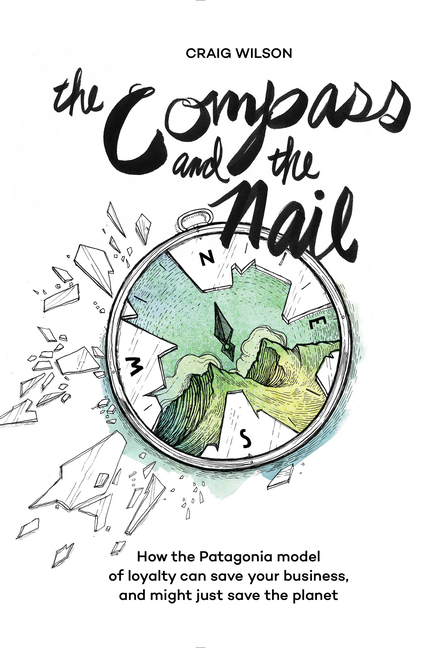Inside the Longlist: Marketing
November 17, 2015
Our Marketing Director Blyth takes a look at the Marketing category of The 2015 800-CEO-READ Business Book Awards longlist.
The old saying goes: “Those that can, do. Those that can’t do...teach. Or write.” Of course we here at 800-CEO-READ know that nothing could be further from the truth, but that doesn’t mean some of our authors don’t do better than others. Which is why, when sifting through the impressive stack of Marketing books for this year’s awards, we paid special attention to those that excel in real-world marketing, not just business book marketing. We love a good, well-written treatise on someone’s new theory of social engagement, but if the proof’s not in the pudding, chances aren’t good we’ll take the time to implement it. The five finalists for Marketing Book of the Year all have the bonafides to make you feel confident it’s worth your time to re-think your well-worn (or just beginning) approach to marketing.

The Compass and The Nail: How the Patagonia Model of Loyalty Can Save Your Business, and Might Just Save the Planet by Craig Wilson
Our company has a long-time fondness for the team at Patagonia. Founder Yvon Chouinard's workplace classic, Let My People Go Surfing, was one of our earliest best sellers. We regularly monitor their pioneering efforts in work/life balance as we doggedly work for a better work environment of our own. And now, gratefully, we get a peek into their world-class branding machine from Craig Wilson, who spearheaded their multi-channel marketing efforts for nearly a decade.
In his first book, Wilson lays out the details of Patagonia’s “Brand Ecosystem” model, which answers the question: “How can some companies create such strong affection for their brands that their customers feel compelled to rave about them?” People identify with the Patagonia brand on a deep, personal level--the holy grail for all branding creatives.
[The] path to long-term sustainable loyalty is based on an unspoken agreement: You believe what I believe and I believe what you believe. Now we can do business from a place of trust and inspiration.
It’s the reason customers of The North Face don’t wear Patagonia and customers of Patagonia don’t wear The North Face. Not because of features and benefits, but because if you believe in conquering nature, you’re likely a fan of The North Face. If you believe in the value of being in nature, you’re likely a fan of Patagonia.”
How well does your company do at drawing this kind of emotional distinction between two nearly identical products?
Does It Work?: 10 Principles for Delivering True Business Value in Digital Marketing by Shane Atchison and Jason Burby
Much like architecture, marketing is an artistic endeavor that is not, in fact, art. A building must perform specific functions (protect people from the weather, adhere to city codes, not collapse), whereas a painting can function freely in a universe of no restrictions. Similarly, if an advertising campaign is gorgeous and creates buzz, but does not [fill in the blank: reduce teen pregnancy, prevent train accidents, sell more books], it does not work as marketing. And, according to Atchison and Burby, should be banished from the industry. They argue for results-oriented marketing, with a focus on making a difference instead of being creative through their company-wide mantra: “Does it Work?”
Does it Work? may seem an easy thing to adopt, but it’s not. It mandates a long-term shift in how you approach digital and marketing and your customer relationships overall. It will change not merely how you look at data and creativity, but how you staff your organization, prioritize among initiatives, and organize and incentivize your people. It will change your relationship to agencies and clients, and maybe even with customers, too. Changes like that don't’ come quickly; they take a strong commitment to making things better. But the good news it, you can start implementing these ideas today. Just start asking, “Does it work?” The answer may surprise you.
This beautifully designed book will help get your company on track for creating real change, using brilliant ideas into business objectives.
Madison Avenue Manslaughter: An Inside View of Fee-Cutting Clients, Profit-Hungry Owners and Declining Ad Agencies by Michael Farmer
If you were one of the many advertising workers that entered the industry based on some romantic notion of the “Mad Men”-era industry, in which your creativity would be endlessly revered, appreciated and compensated, well, surprise. Most of you are instead dealing with a strategic problem facing advertising agencies, namely the traditional way of charging clients (based on client budgets and agency salaries) is leading to scope creep and an overwhelming workload for all involved. Look past the blood-spattered cover imagery of Farmer’s book to find a riveting historical perspective of the industry, and a strong argument for changing the way agencies charge for their work, holding them accountable for low performance:
Agencies and their clients need to recapture some of the respect, fun and profitability of working in what was once one of the most fulfilling and glamourous of industries but has become a grim sweatshop for the people who do the work.
Much like Does it Work?, Farmer’s book aims to shift the focus of agencies from “creativity & service” to “results for clients” by laying out a plan for CEOs “who wish to restore organizational health, financial well-being and renewed strategic relevance for their ad agencies.”
The Smarter Screen: Surprising Ways to Influence and Improve Behavior by Shlomo Bernartzi with Jonah Leher
By now, we’ve all heard about the “fly in the urinal” study--by placing an image of a house fly in a urinal, aim is greatly improved. This is what is known as a “nudge,” the theory accredited to another author on our longlist, Richard Thaler. Nudges use positive reinforcement and indirect suggestions to try to achieve non-forced compliance, and are all the rage these days. Both President Obama and Prime Minister David Cameron have created specialized task forces to utilize nudge theory in efforts to govern their people. Not to be outdone, the state of California recently announced a collaboration with Bernatzi’s own California Digital Nudge Initiative.
Whereas some people criticize nudges as coercion, Bernartzi’s work is firmly planted in the “doing good” camp, and aims to help people make the right decision for them, and not make the decision on their behalf. For those skeptics, who think that our obsession with the online word is ruining the “real” one, you won’t find sympathy here:
“This book is not about… how smartphones makes us stupid. It is not a requiem for some predigital paradise. Instead, this book is about how screens can be designed to make us smarter. It’s a book of behavioral solutions and practical tools that can improve our digital lives.”
This well-written book (with help from the infamous Jonah Lehrer) teaches you how to apply nudge theory to your business goals. Think of it as a “Digital nudging toolkit.” Shlomo’s work in the realm of behavioural economics has much to offer to today’s digital marketing professional.
X: The Experience When Business Meets Design by Brian Solis
Lastly, we have on the list a book from an author we’ve known for quite some time. Solis’s The End of Business As Usual was a four-time bestseller for us, and he’s written two engaging manifestos on innovation and transformation for our sister site, ChangeThis. In his new book, Solis turns his focus is on experience architecture: “Experiences are more important than products now. In fact, experiences are products.”
Examples from American Airlines, Disney, Lego, Tesla, and an in-depth study of Apple’s iPad exemplify the rich results from Solis’ insistence on an un-siloed work place, one in which marketing, sales, product development, support, and loyalty teams all work towards a unified goal of serving the customer.
“In order to be competitive, brands must get better not only at understanding and satisfying customers’ wants and needs but at anticipating them, even before the customers know what they want and need. This type of experience design is referred to as creating proactive experiences, and these are quickly becoming the new standard.”
If your company is looking to invest more deeply on improving customer experience, Solis’s book shows how the subsequent word-of-mouth can yield a more effective marketing than traditional advertising.






